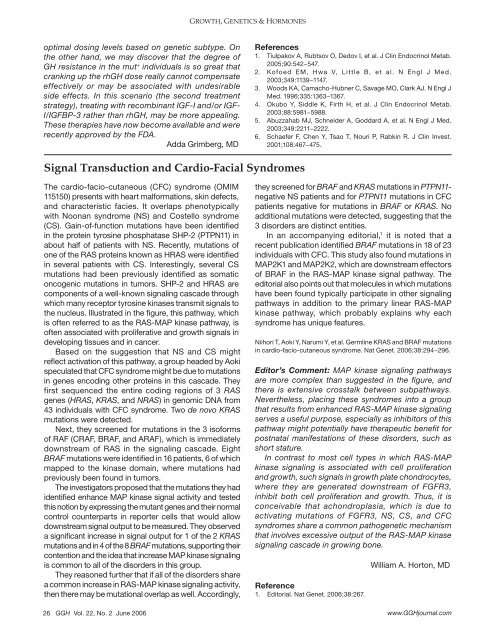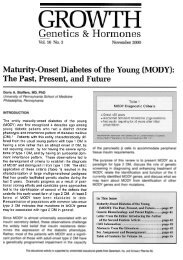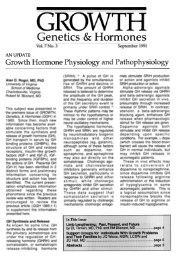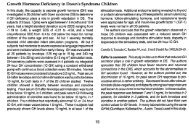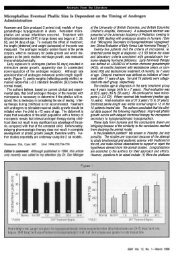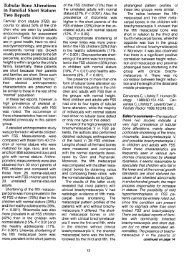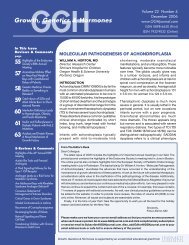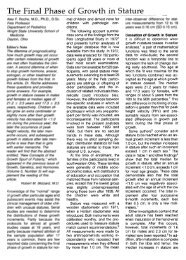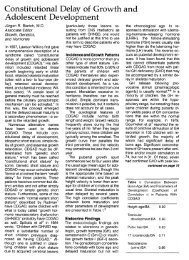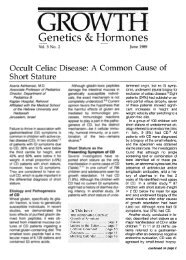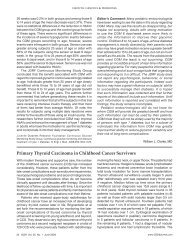Download pdf of current issue - GGH Journal
Download pdf of current issue - GGH Journal
Download pdf of current issue - GGH Journal
Create successful ePaper yourself
Turn your PDF publications into a flip-book with our unique Google optimized e-Paper software.
GROWTH, GENETICS & HORMONES<br />
optimal dosing levels based on genetic subtype. On<br />
the other hand, we may discover that the degree <strong>of</strong><br />
GH resistance in the mut + individuals is so great that<br />
cranking up the rhGH dose really cannot compensate<br />
effectively or may be associated with undesirable<br />
side effects. In this scenario (the second treatment<br />
strategy), treating with recombinant IGF-I and/or IGF-<br />
I/IGFBP-3 rather than rhGH, may be more appealing.<br />
These therapies have now become available and were<br />
recently approved by the FDA.<br />
Adda Grimberg, MD<br />
References<br />
1. Tiulpakov A, Rubtsov O, Dedov I, et al. J Clin Endocrinol Metab.<br />
2005;90:542−547.<br />
2. K<strong>of</strong>oed EM, Hwa V, Lit tle B, et al. N Engl J Med.<br />
2003;349:1139−1147.<br />
3. Woods KA, Camacho-Hubner C, Savage MO, Clark AJ. N Engl J<br />
Med. 1996;335:1363−1367.<br />
4. Okubo Y, Siddle K, Firth H, et al. J Clin Endocrinol Metab.<br />
2003;88:5981−5988.<br />
5. Abuzzahab MJ, Schneider A, Goddard A, et al. N Engl J Med.<br />
2003;349:2211−2222.<br />
6. Schaefer F, Chen Y, Tsao T, Nouri P, Rabkin R. J Clin Invest.<br />
2001;108:467−475.<br />
Signal Transduction and Cardio-Facial Syndromes<br />
The cardio-facio-cutaneous (CFC) syndrome (OMIM<br />
115150) presents with heart malformations, skin defects,<br />
and characteristic facies. It overlaps phenotypically<br />
with Noonan syndrome (NS) and Costello syndrome<br />
(CS). Gain-<strong>of</strong>-function mutations have been identified<br />
in the protein tyrosine phosphatase SHP-2 (PTPN11) in<br />
about half <strong>of</strong> patients with NS. Recently, mutations <strong>of</strong><br />
one <strong>of</strong> the RAS proteins known as HRAS were identified<br />
in several patients with CS. Interestingly, several CS<br />
mutations had been previously identified as somatic<br />
oncogenic mutations in tumors. SHP-2 and HRAS are<br />
components <strong>of</strong> a well-known signaling cascade through<br />
which many receptor tyrosine kinases transmit signals to<br />
the nucleus. Illustrated in the figure, this pathway, which<br />
is <strong>of</strong>ten referred to as the RAS-MAP kinase pathway, is<br />
<strong>of</strong>ten associated with proliferative and growth signals in<br />
developing t<strong>issue</strong>s and in cancer.<br />
Based on the suggestion that NS and CS might<br />
reflect activation <strong>of</strong> this pathway, a group headed by Aoki<br />
speculated that CFC syndrome might be due to mutations<br />
in genes encoding other proteins in this cascade. They<br />
first sequenced the entire coding regions <strong>of</strong> 3 RAS<br />
genes (HRAS, KRAS, and NRAS) in genomic DNA from<br />
43 individuals with CFC syndrome. Two de novo KRAS<br />
mutations were detected.<br />
Next, they screened for mutations in the 3 is<strong>of</strong>orms<br />
<strong>of</strong> RAF (CRAF, BRAF, and ARAF), which is immediately<br />
downstream <strong>of</strong> RAS in the signaling cascade. Eight<br />
BRAF mutations were identified in 16 patients, 6 <strong>of</strong> which<br />
mapped to the kinase domain, where mutations had<br />
previously been found in tumors.<br />
The investigators proposed that the mutations they had<br />
identified enhance MAP kinase signal activity and tested<br />
this notion by expressing the mutant genes and their normal<br />
control counterparts in reporter cells that would allow<br />
downstream signal output to be measured. They observed<br />
a significant increase in signal output for 1 <strong>of</strong> the 2 KRAS<br />
mutations and in 4 <strong>of</strong> the 8 BRAF mutations, supporting their<br />
contention and the idea that increase MAP kinase signaling<br />
is common to all <strong>of</strong> the disorders in this group.<br />
They reasoned further that if all <strong>of</strong> the disorders share<br />
a common increase in RAS-MAP kinase signaling activity,<br />
then there may be mutational overlap as well. Accordingly,<br />
they screened for BRAF and KRAS mutations in PTPN11-<br />
negative NS patients and for PTPN11 mutations in CFC<br />
patients negative for mutations in BRAF or KRAS. No<br />
additional mutations were detected, suggesting that the<br />
3 disorders are distinct entities.<br />
In an accompanying editorial, 1 it is noted that a<br />
recent publication identified BRAF mutations in 18 <strong>of</strong> 23<br />
individuals with CFC. This study also found mutations in<br />
MAP2K1 and MAP2K2, which are downstream effectors<br />
<strong>of</strong> BRAF in the RAS-MAP kinase signal pathway. The<br />
editorial also points out that molecules in which mutations<br />
have been found typically participate in other signaling<br />
pathways in addition to the primary linear RAS-MAP<br />
kinase pathway, which probably explains why each<br />
syndrome has unique features.<br />
Niihori T, Aoki Y, Narumi Y, et al. Germline KRAS and BRAF mutations<br />
in cardio-facio-cutaneous syndrome. Nat Genet. 2006;38:294−296.<br />
Editor’s Comment: MAP kinase signaling pathways<br />
are more complex than suggested in the figure, and<br />
there is extensive crosstalk between subpathways.<br />
Nevertheless, placing these syndromes into a group<br />
that results from enhanced RAS-MAP kinase signaling<br />
serves a useful purpose, especially as inhibitors <strong>of</strong> this<br />
pathway might potentially have therapeutic benefit for<br />
postnatal manifestations <strong>of</strong> these disorders, such as<br />
short stature.<br />
In contrast to most cell types in which RAS-MAP<br />
kinase signaling is associated with cell proliferation<br />
and growth, such signals in growth plate chondrocytes,<br />
where they are generated downstream <strong>of</strong> FGFR3,<br />
inhibit both cell proliferation and growth. Thus, it is<br />
conceivable that achondroplasia, which is due to<br />
activating mutations <strong>of</strong> FGFR3, NS, CS, and CFC<br />
syndromes share a common pathogenetic mechanism<br />
that involves excessive output <strong>of</strong> the RAS-MAP kinase<br />
signaling cascade in growing bone.<br />
Reference<br />
1. Editorial. Nat Genet. 2006;38:267.<br />
William A. Horton, MD<br />
26 <strong>GGH</strong> Vol. 22, No. 2 June 2006 www.<strong>GGH</strong>journal.com


